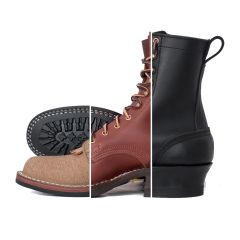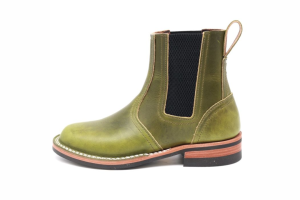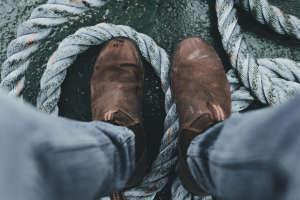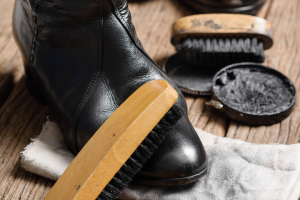What Is A Boot Last
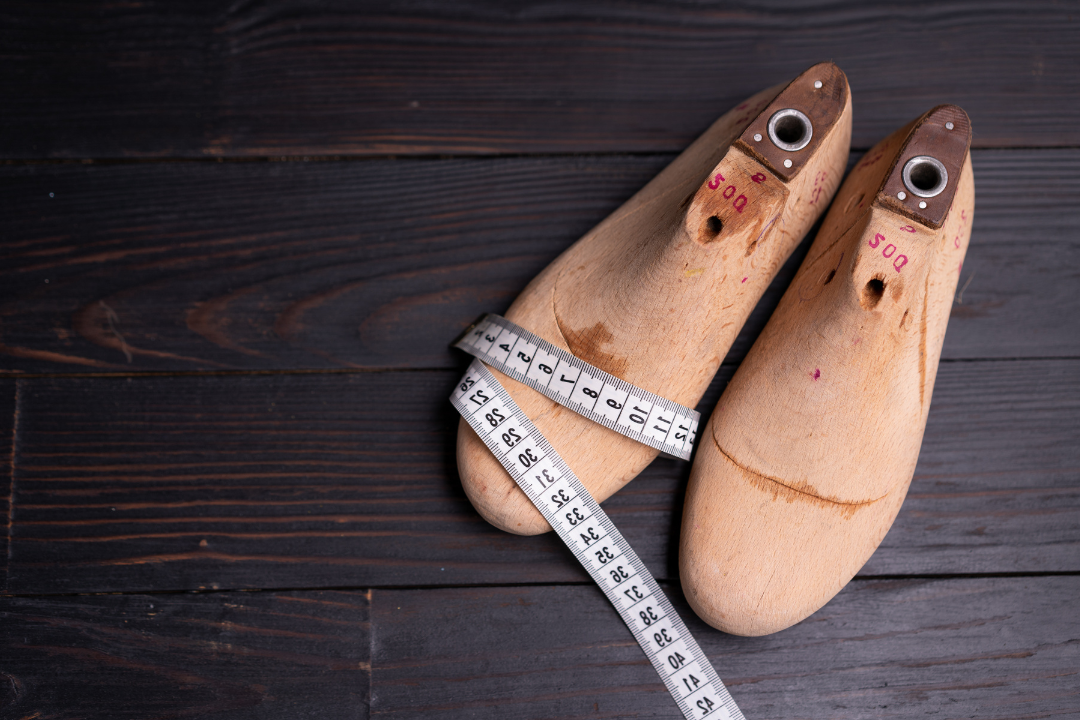
Key Takeaways:
- Essential Tool: The boot last is a crucial tool in defining the fit, style, and ergonomic comfort of a boot, directly influencing its quality and durability.
- Variety of Lasts: There are multiple types of lasts like standard, wide, narrow, and specialty, each designed to cater to different foot shapes and needs.
- Impact on Health and Performance: The right boot last enhances comfort, prevents foot problems, and aligns with specific activities to boost performance and extend the boot lifespan.
Nick's Boots is a leader in footwear innovation, drawing on decades of experience to create boots designed for living, not just wearing. As industry pioneers, we maintain rigorous standards of quality and durability in every pair we craft. Central to our shoemaking process is a key piece of technology—the boot last. This tool is foundational in ensuring that each pair of boots we produce meets our high standards.
This piece will explain what a boot last is and its importance in boot design. We'll explore how the boot last plays a critical role in shaping the boot and influencing its functionality. Additionally, we'll discuss how the boot last impacts everything from the fit of the boot to the health of your feet. By understanding the significance of boot lasts you can make informed choices about footwear that offers both comfort and long-term support.


Understanding Boot Lasts
A boot last is the form used during the shoemaking process that shapes the boot's size, fit, and style. Resembling the human foot, a boot last defines the boot's dimensions, including its width, toe shape, heel height, and arch, essentially molding the overall ergonomic design and comfort. This form can be made from various materials like wood or plastic and varies to accommodate different foot types and boot styles. It's fundamental in creating boots that are both functional and comfortable.
The Role Of A Boot Last In Boot Design
Influence On Aesthetic Appeal
At Nicks Boots, we understand that the boot last directly shapes the boot's visual profile, dictating whether it presents a rugged or refined appearance. This foundation determines everything from the sleekness of the toe to the curve of the arch, allowing us to design boots that are not only functional but also stylistically distinct. A well-crafted last ensures that each pair of boots reflects intended aesthetic nuances, appealing to a wide range of preferences and styles.
Impact On Comfort And Fit
The comfort of a boot begins with its last, which molds to the contours of the foot, providing a custom-like fit. This crucial component decides the spaciousness of the toe box and the snugness around the heel, factors essential for long-term wearability. By choosing the appropriate last, we ensure that each boot serves as a natural extension of the foot, enhancing comfort without compromising on style or durability.
Functional Alignment And Performance
The functional performance of boots, especially in demanding conditions, relies heavily on the precision of the boot last. It aligns the foot in an anatomically correct position, crucial for reducing fatigue and increasing stability. Whether it’s scaling rugged terrains or enduring long workdays, the right last helps distribute weight evenly, providing essential support and preventing common foot ailments.
Types Of Boot Lasts
Standard Lasts
Standard lasts are designed to meet the needs of a broad user base, offering a well-rounded fit that suits most foot shapes without specialized adjustments. They provide an optimal balance between comfort and support, ensuring that the boots can be worn comfortably for long periods. These lasts are ideal for daily use, making them a staple in both casual and work boot designs. By focusing on general fit, standard lasts aim to satisfy a wide demographic, ensuring high satisfaction with minimal customization.
Wide Lasts
Wide lasts are essential for individuals with wider feet or those who experience discomfort in conventional fits. These lasts offer additional space in the toe box and forefoot area, preventing blisters and allowing for better blood circulation. They are particularly beneficial for workers who spend long hours on their feet, as they help in reducing foot fatigue and increase overall comfort. Wide lasts ensure that the boots do not constrict or bind the feet, providing a healthy environment for foot movement.
Narrow Lasts
Narrow lasts are tailored to provide a precise fit for individuals with slender feet, ensuring that the boots are securely fitted without slipping. This fit enhances the wearer's stability and balance, making the boots ideal for activities that require agile and precise foot movements. The snug fit also helps prevent internal movement that can lead to friction and blisters. For those with narrow feet, these lasts help in achieving a customized feel that supports natural foot alignment.
Specialty Lasts
Specialty lasts cater to unique foot shapes and conditions, offering targeted support and comfort where it's needed most. These lasts are crafted to accommodate specific issues such as high arches, flat feet, or other orthopedic concerns. By modifying the arch support and heel cup, specialty lasts can significantly improve foot health and comfort. They are crucial for individuals who cannot find comfort in standard shoe forms, providing a solution that allows them to wear boots without discomfort.
Importance Of Choosing The Right Boot Last
- Enhancing Comfort and Fit: Choosing the right boot last is paramount in ensuring optimal comfort and fit, as it conforms to the foot’s natural shape, reducing discomfort during wear. This precision fit minimizes the risk of foot pain and injuries caused by ill-fitting shoes, crucial for those spending extensive hours on their feet.
- Preventing Foot Problems: The correct boot last can help prevent common foot issues such as bunions, corns, and blisters, which arise from continuous pressure and friction. Properly fitting lasts provide adequate space and support, crucial in maintaining foot health, especially under strenuous conditions.
- Enhancing Boot Durability: Well-chosen lasts contribute to the longevity of boots by maintaining their shape and structural integrity over time. This alignment ensures that the boots wear down evenly, preventing premature breakdown and extending their usable life, representing a sound investment.
- Suitability for Specific Activities: Different activities require boots with specific characteristics, and the right last can tailor a boot's performance to these needs. For instance, a last designed for hiking will differ markedly from one intended for industrial work, optimizing each boot for its intended use.
How Boot Lasts Affects Foot Health
Proper Alignment And Support
Proper alignment and support from a well-crafted boot last are fundamental for avoiding foot and joint issues. The right last aligns the foot correctly, reducing undue stress on the ankles, knees, and hips, which can lead to long-term health problems. It also ensures that the foot is positioned optimally within the boot, preventing slippage that can cause blisters and other discomforts. Maintaining this alignment across various activities helps safeguard against injuries and enhances walking or standing comfort.
Customized Fit For Different Foot Shapes
Customized fit is crucial for accommodating the unique contours of each foot, ensuring comfort and preventing conditions such as bunions and hammertoes. A boot last that mirrors the natural shape of the foot distributes weight evenly, which is essential for good circulation and reducing pressure points. This kind of fit also allows for better movement control, reducing the chance of accidents and discomfort. It's particularly important for those with specific foot shapes or conditions that require additional space or support.
Reduction Of Foot Fatigue
Reduction of foot fatigue is vital for anyone who spends significant time on their feet. A supportive boot last helps maintain proper foot posture, which conserves energy and minimizes strain on the foot muscles and ligaments. This support allows for longer periods of activity without discomfort, promoting overall foot health and stamina. Additionally, reducing foot fatigue can help prevent more serious foot conditions from developing, keeping feet healthy and active longer.
Practical Tips For Identifying Quality Boot Lasts
Examine The Shape And Contours
When selecting a boot, it's crucial to examine the last's shape and contours, ensuring they accurately mimic the human foot. Look for a natural alignment of the arch and adequate room in the toe box that allows for natural toe movement. A well-defined heel cup is also essential, as it supports and stabilizes the heel. These features contribute to overall foot health and comfort, particularly important in footwear designed for long wear periods.
Check For Material And Construction
The material and construction of a boot last are indicators of its quality and longevity. High-quality lasts are typically crafted from durable materials such as hardwood or advanced synthetic composites that resist wear and maintain their shape under pressure. These materials also contribute to the overall stability and performance of the boot, affecting how well the boot holds up in various environmental conditions.
Feel The Fit
Trying on boots is essential to test the quality of the last firsthand. A properly constructed last should provide a snug fit that supports the foot without restricting movement or causing discomfort. It should feel comfortable from the first wear, without a long break-in period, ensuring the boot adapts well to the shape of your foot. This immediate comfort is a good indicator of a well-designed last.
Consult Expert Reviews And Recommendations
Expert reviews and customer feedback are invaluable when assessing the quality of boot lasts. These reviews can provide insights into how the lasts hold up over time and under different usage conditions. Experts might also highlight which lasts are best for specific activities or foot types, guiding your decision-making process. Seeking out reputable sources for these reviews ensures that you are getting reliable information that can influence your purchase positively.


Final Thoughts
The boot last is essential in shaping both the appearance and functionality of a boot, reflecting a deep commitment to craftsmanship. It not only determines the boot's look but also ensures it fits well, enhancing comfort and durability. Recognizing the role of the boot last underscores the necessity of choosing footwear that supports the foot's shape, health, and the wearer's overall lifestyle. Various types of lasts are designed to meet specific needs, improving the boots' effectiveness for particular activities and conditions. This insight empowers consumers to make knowledgeable decisions, resulting in enhanced satisfaction and well-being. In essence, a well-selected boot last is critical for the footwear's longevity and the wearer's health.
Read also:
Frequently Asked Questions About Boot Lasts
Why does the material of a boot last matter in bootmaking?
The material of a boot last influences the boot's durability and how well it retains its shape. Materials like hardwood or high-grade synthetics ensure the last withstands the pressures of bootmaking and wears well over time, affecting the overall quality of the finished product.
Can the same boot last be used for different styles of boots?
While a boot last can be adapted for different styles, each style may require modifications to the last to ensure the boot meets the specific design and comfort needs of that style. For example, a boot last used for a rugged outdoor boot might be altered for a dress boot to change the toe shape or arch support.
How do boot lasts affect the break-in period of boots?
A well-designed boot last minimizes the break-in period by ensuring a closer initial fit and comfort. A last that closely mimics the natural contours of the foot allows the boot to adapt more quickly to the wearer's foot, reducing discomfort and adjustment time.
What role does a boot last play in the custom boot-making process?
In custom bootmaking, the last is crucial for achieving a personalized fit. It is often adjusted or crafted from scratch to meet the specific measurements and needs of an individual’s foot, ensuring optimal comfort and performance.
How often do bootmakers update their last designs?
Bootmakers may update their last designs to reflect changes in footwear trends, ergonomic research, and customer feedback. This ensures that the lasts remain relevant and effective in producing comfortable, stylish, and functional boots.
Are there environmental considerations in choosing boot last materials?
Yes, choosing sustainable materials for boot lasts, like responsibly sourced wood or recycled synthetics, can reduce the environmental impact. Bootmakers are increasingly considering these options to align with eco-friendly practices.
How does a boot last influence the overall weight of a boot?
The design of the last can affect the distribution and amount of materials used in the boot, which in turn influences its weight. A well-designed last ensures that the boot is not overly heavy, maintaining comfort without sacrificing durability.
What is the difference between a boot last and a shoe last?
The main difference lies in their specific design features; boot lasts often accommodate higher ankles and potentially thicker materials than shoe lasts, which are generally designed for lower-cut footwear.
Can a poorly designed boot last affect foot health?
Yes, a poorly designed last can lead to improper foot alignment and support, potentially causing discomfort, blisters, and long-term foot issues like bunions or hammertoes.
How can consumers evaluate the quality of a boot last?
Consumers can evaluate the quality of a boot last by checking for a snug, comfortable fit, looking for materials that feel durable, and reading reviews or seeking advice from footwear experts.

